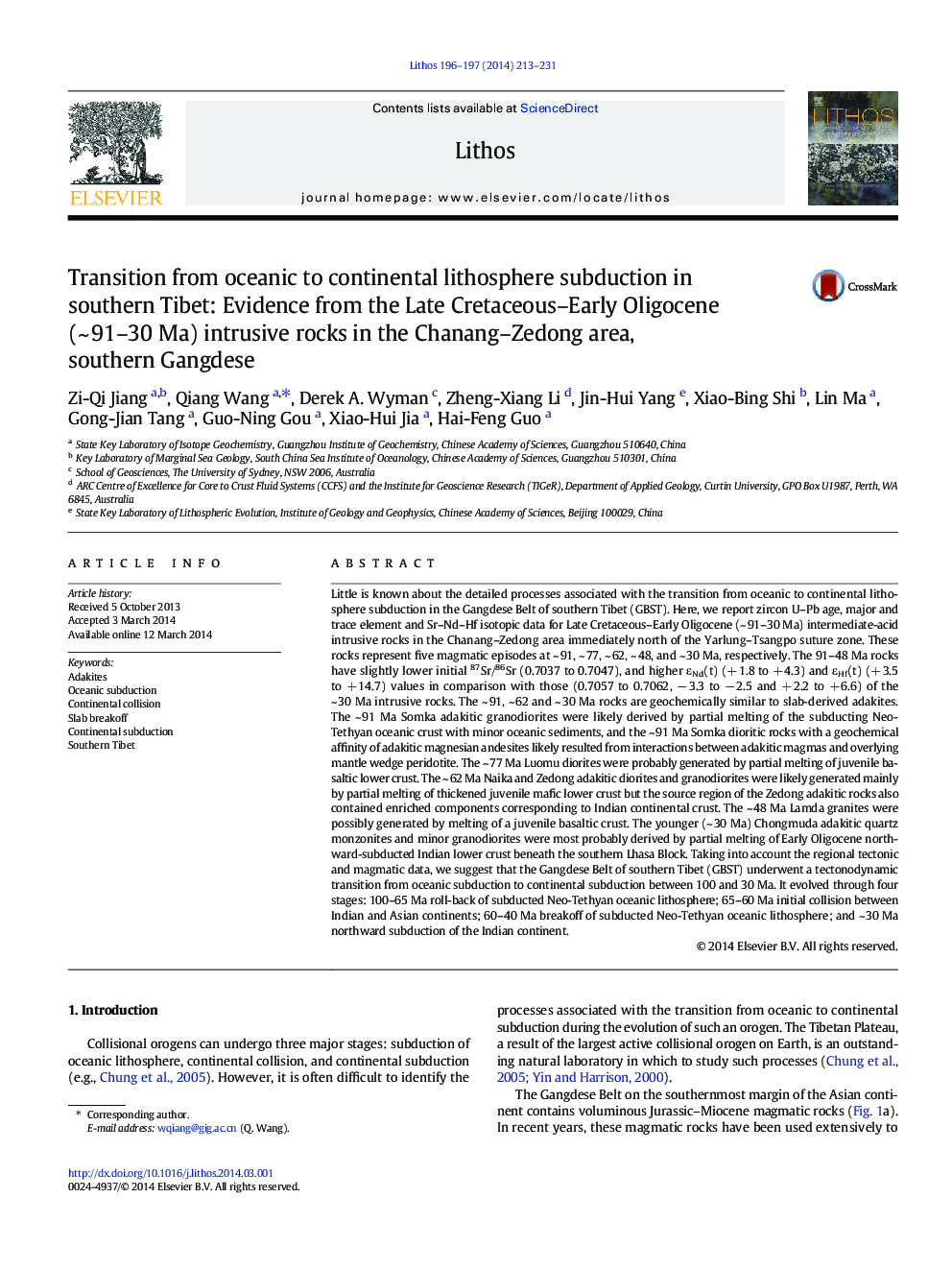| کد مقاله | کد نشریه | سال انتشار | مقاله انگلیسی | نسخه تمام متن |
|---|---|---|---|---|
| 4715983 | 1638678 | 2014 | 19 صفحه PDF | دانلود رایگان |

• Late Cretaceous–Early Oligocene (~ 91–30 Ma) intrusive rocks in southern Gangdese
• 100–65 Ma roll-back of subducted Neo-Tethyan oceanic lithosphere
• 65–60 Ma initial collision between Indian and Asian continents
• 60–40 Ma breakoff of subducted Neo-Tethyan oceanic lithosphere
• ~ 30 Ma northward subduction of the Indian continent
Little is known about the detailed processes associated with the transition from oceanic to continental lithosphere subduction in the Gangdese Belt of southern Tibet (GBST). Here, we report zircon U–Pb age, major and trace element and Sr–Nd–Hf isotopic data for Late Cretaceous–Early Oligocene (~ 91–30 Ma) intermediate-acid intrusive rocks in the Chanang–Zedong area immediately north of the Yarlung–Tsangpo suture zone. These rocks represent five magmatic episodes at ~ 91, ~ 77, ~ 62, ~ 48, and ~ 30 Ma, respectively. The 91–48 Ma rocks have slightly lower initial 87Sr/86Sr (0.7037 to 0.7047), and higher εNd(t) (+ 1.8 to + 4.3) and εHf(t) (+ 3.5 to + 14.7) values in comparison with those (0.7057 to 0.7062, − 3.3 to − 2.5 and + 2.2 to + 6.6) of the ~ 30 Ma intrusive rocks. The ~ 91, ~ 62 and ~ 30 Ma rocks are geochemically similar to slab-derived adakites. The ~ 91 Ma Somka adakitic granodiorites were likely derived by partial melting of the subducting Neo-Tethyan oceanic crust with minor oceanic sediments, and the ~ 91 Ma Somka dioritic rocks with a geochemical affinity of adakitic magnesian andesites likely resulted from interactions between adakitic magmas and overlying mantle wedge peridotite. The ~ 77 Ma Luomu diorites were probably generated by partial melting of juvenile basaltic lower crust. The ~ 62 Ma Naika and Zedong adakitic diorites and granodiorites were likely generated mainly by partial melting of thickened juvenile mafic lower crust but the source region of the Zedong adakitic rocks also contained enriched components corresponding to Indian continental crust. The ~ 48 Ma Lamda granites were possibly generated by melting of a juvenile basaltic crust. The younger (~ 30 Ma) Chongmuda adakitic quartz monzonites and minor granodiorites were most probably derived by partial melting of Early Oligocene northward-subducted Indian lower crust beneath the southern Lhasa Block. Taking into account the regional tectonic and magmatic data, we suggest that the Gangdese Belt of southern Tibet (GBST) underwent a tectonodynamic transition from oceanic subduction to continental subduction between 100 and 30 Ma. It evolved through four stages: 100–65 Ma roll-back of subducted Neo-Tethyan oceanic lithosphere; 65–60 Ma initial collision between Indian and Asian continents; 60–40 Ma breakoff of subducted Neo-Tethyan oceanic lithosphere; and ~ 30 Ma northward subduction of the Indian continent.
Journal: Lithos - Volumes 196–197, May 2014, Pages 213–231